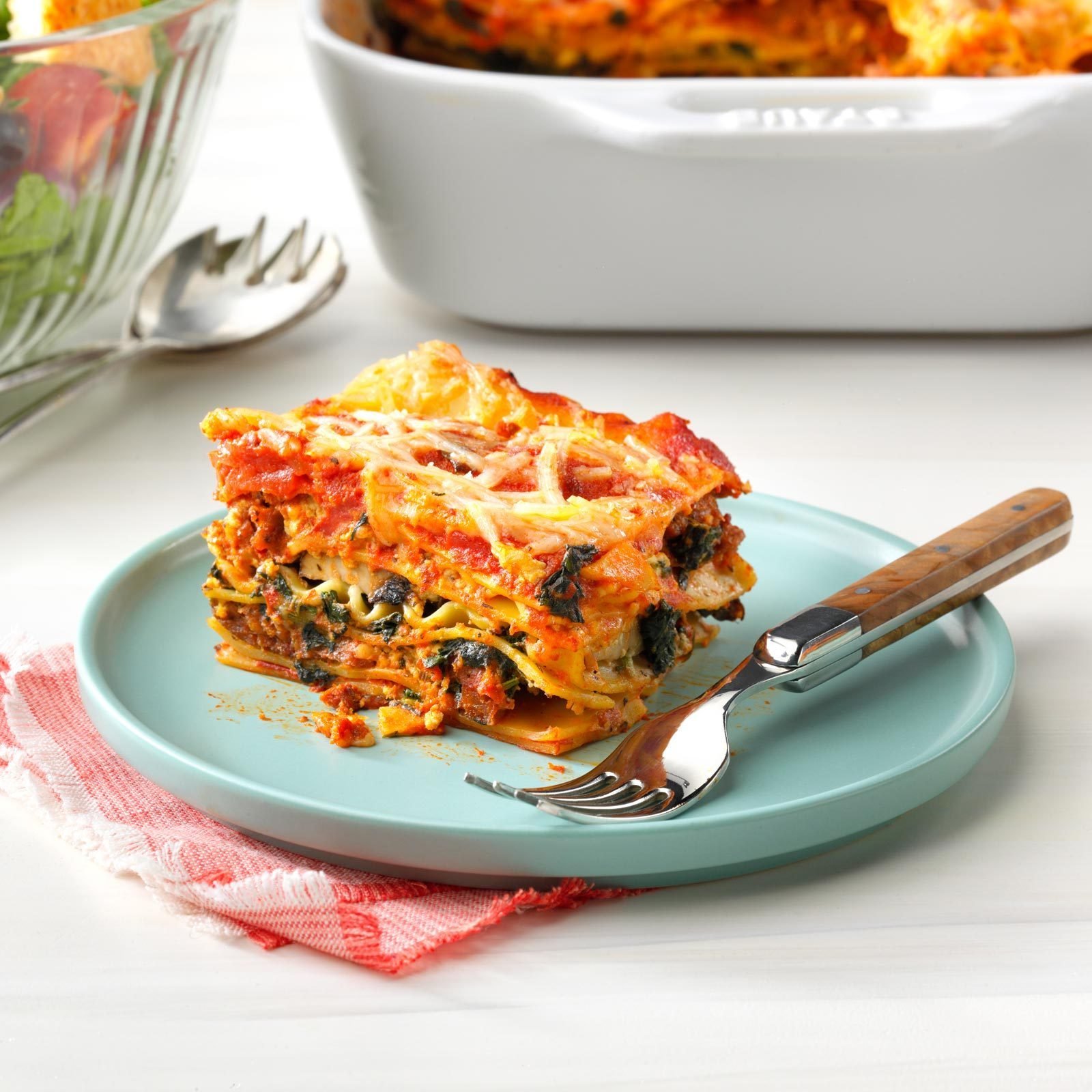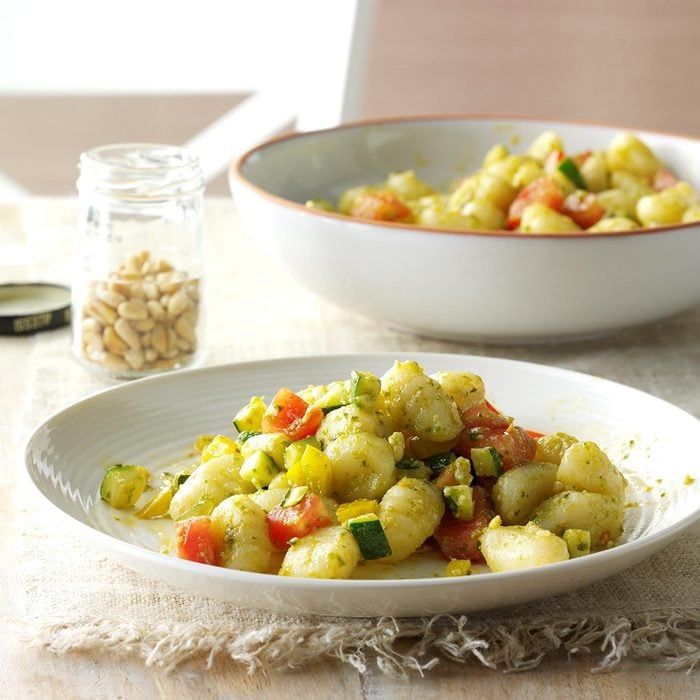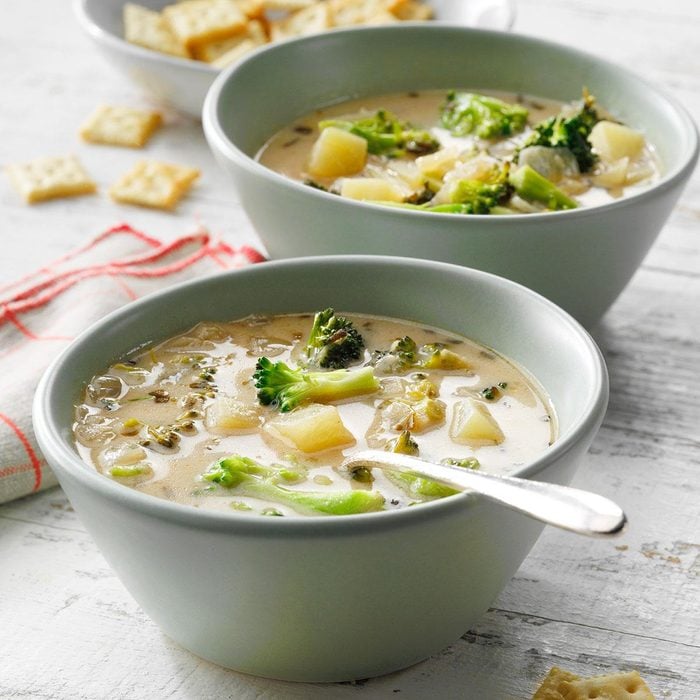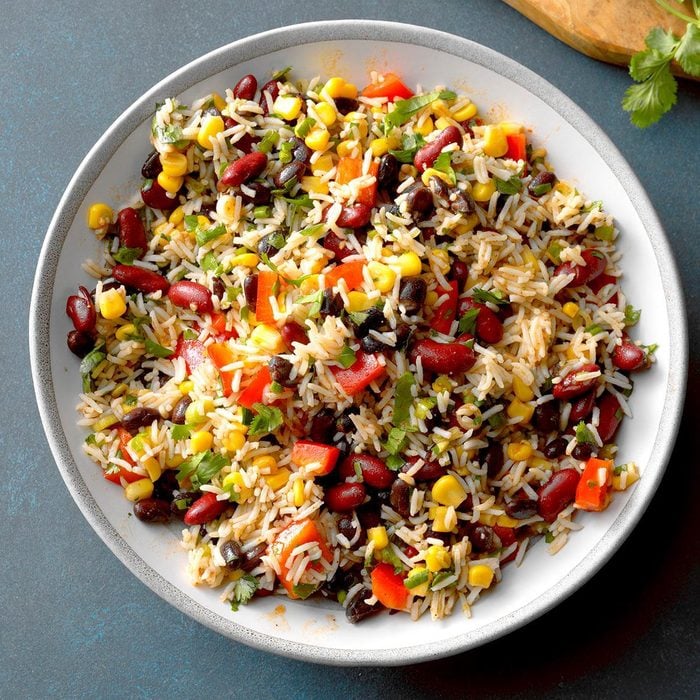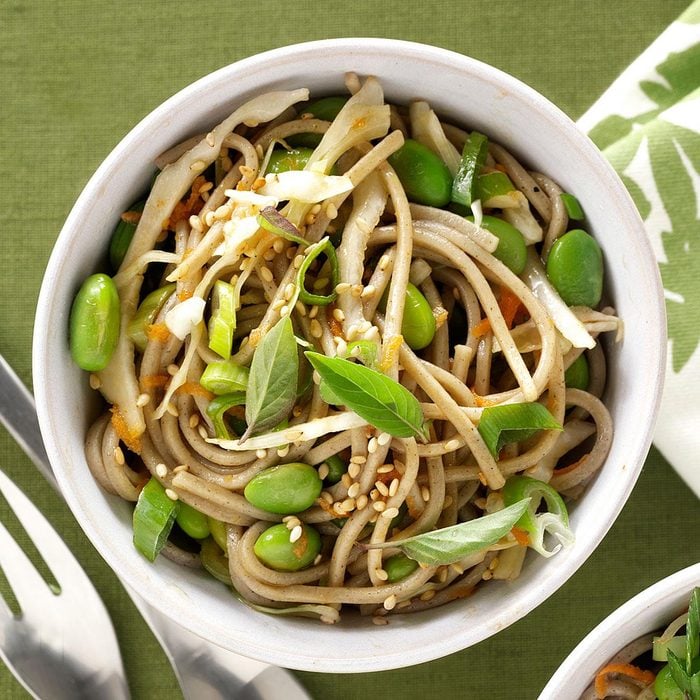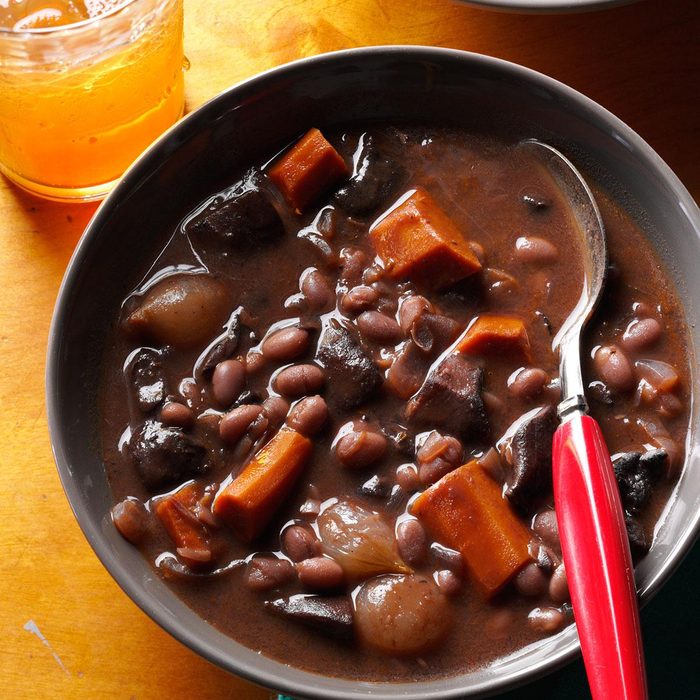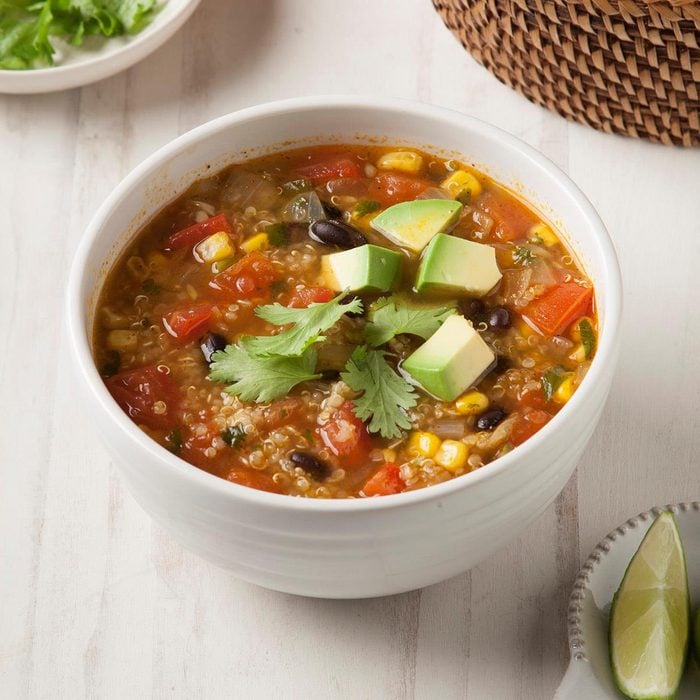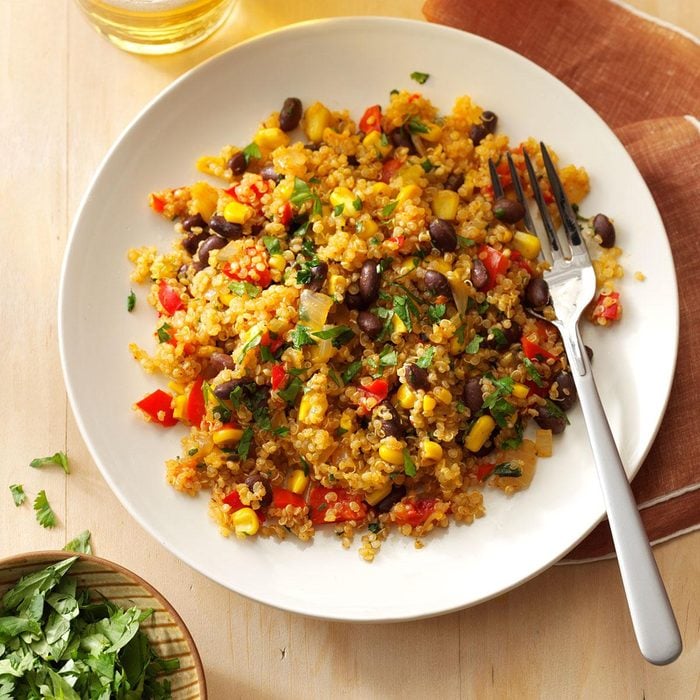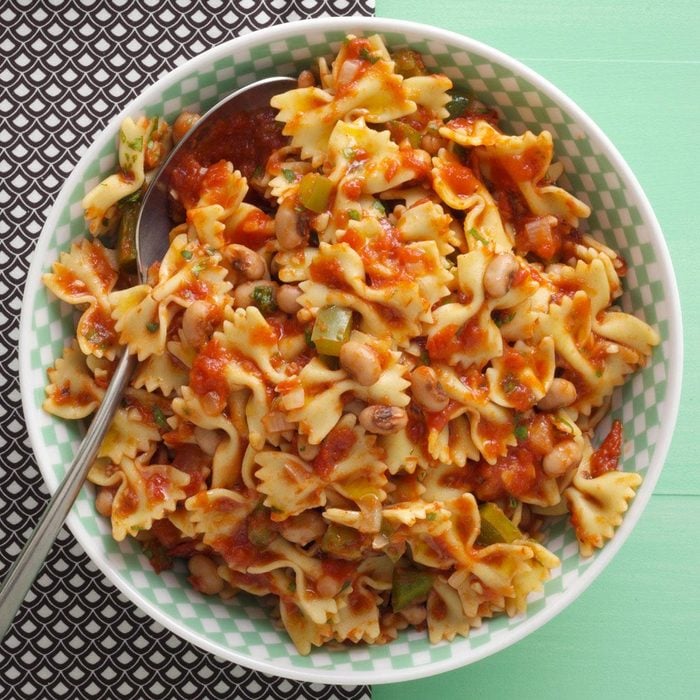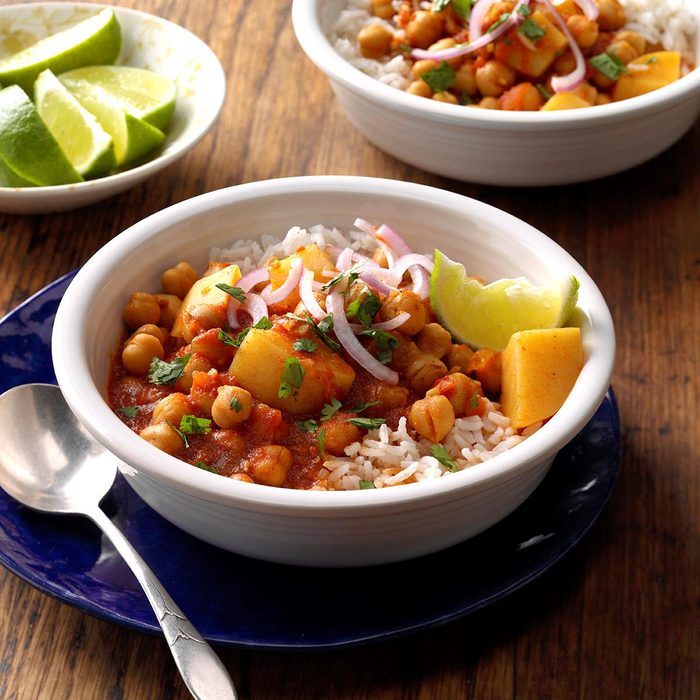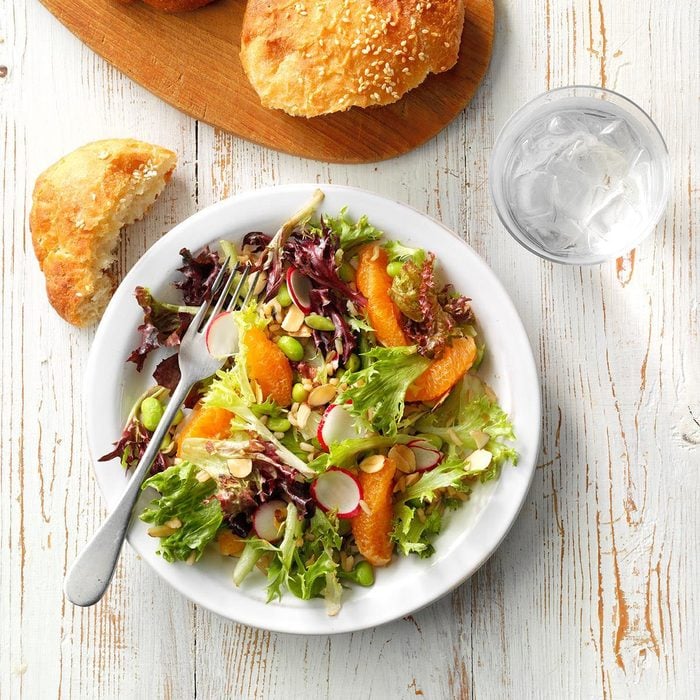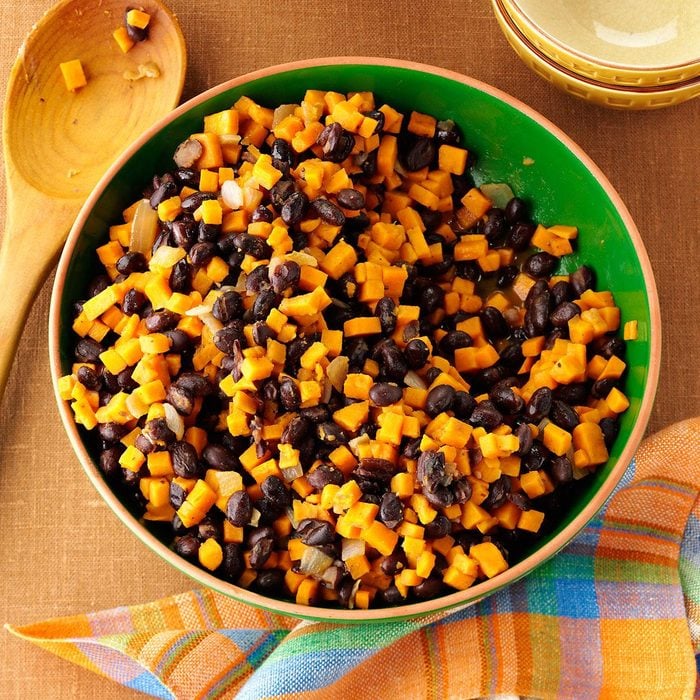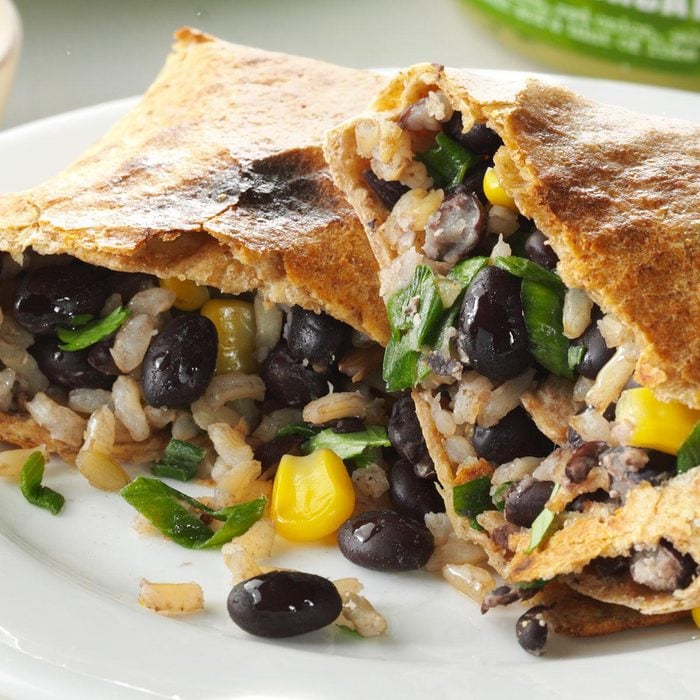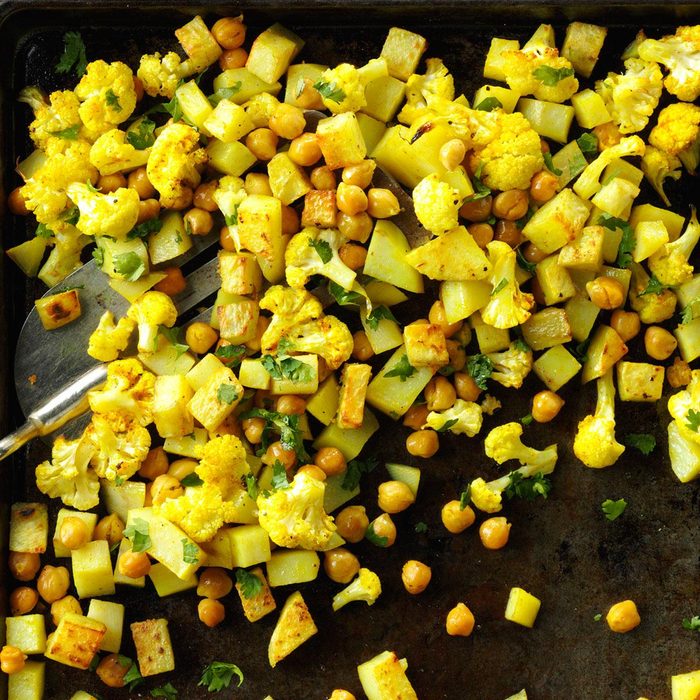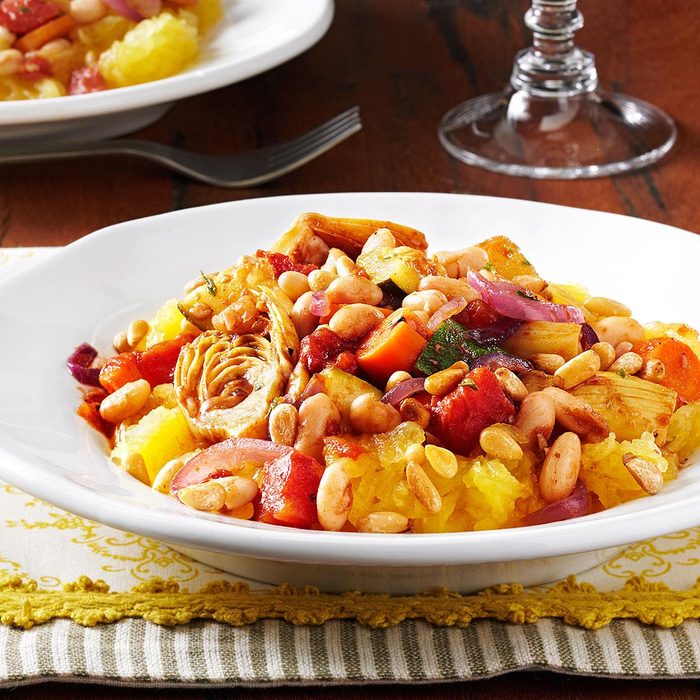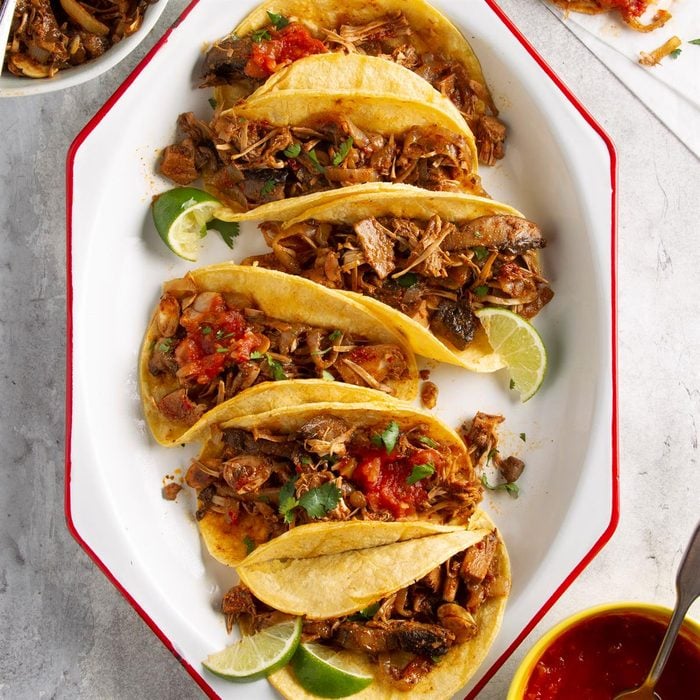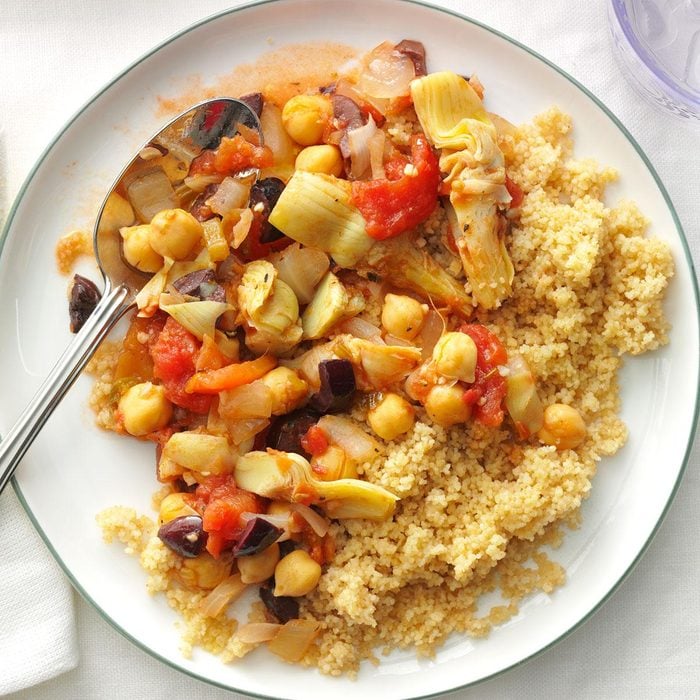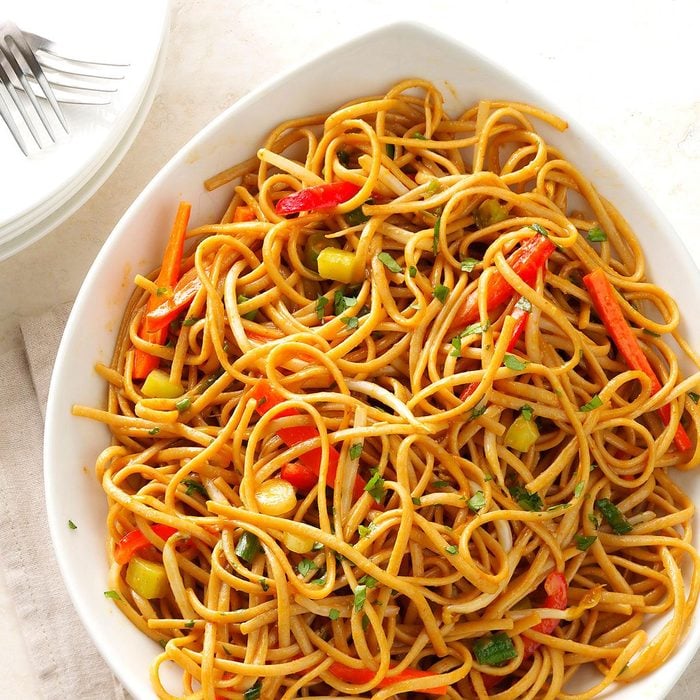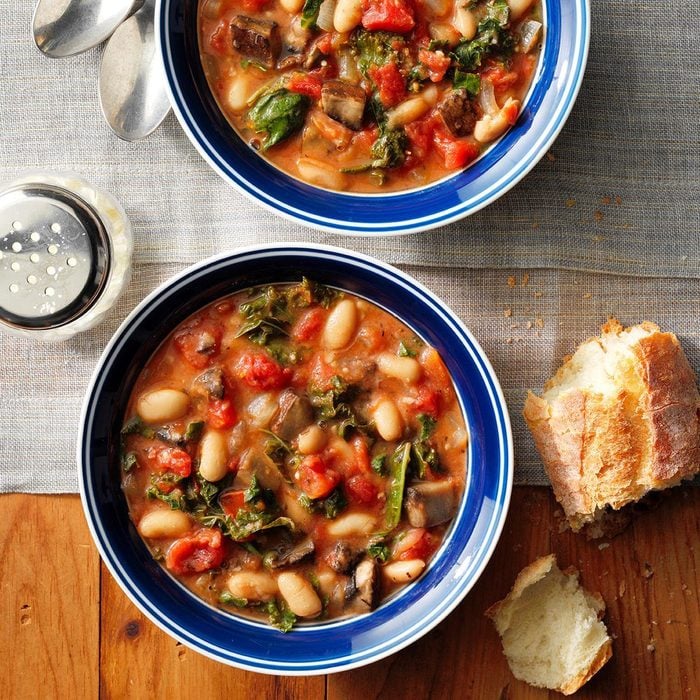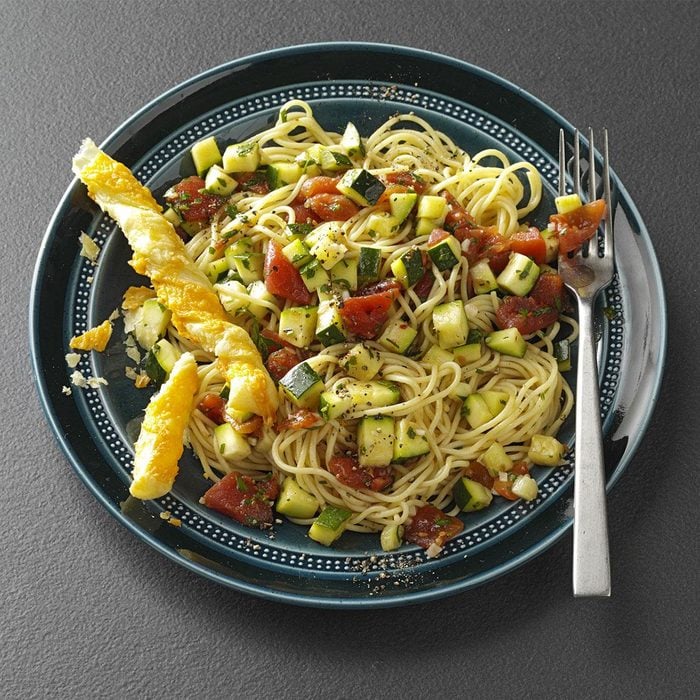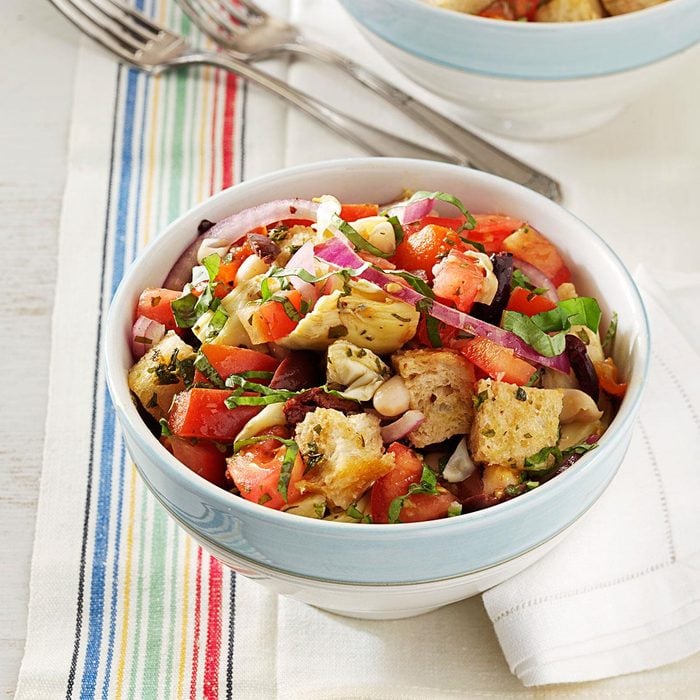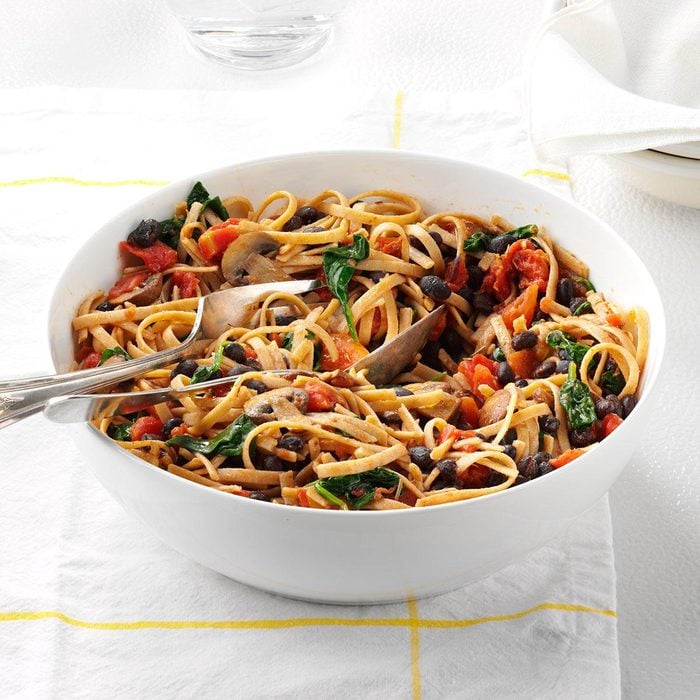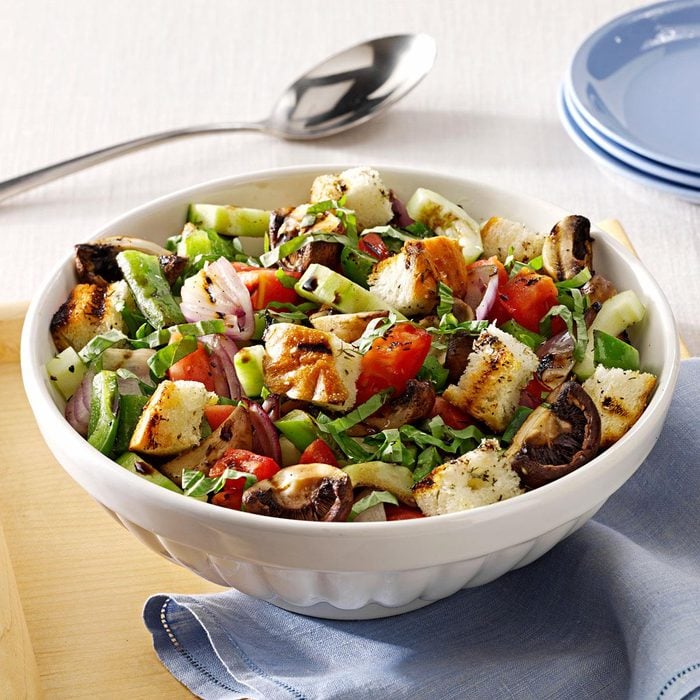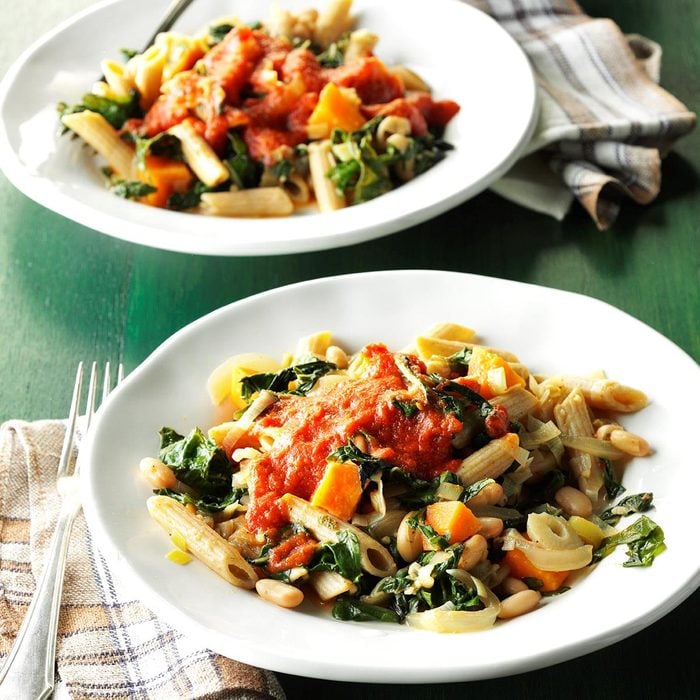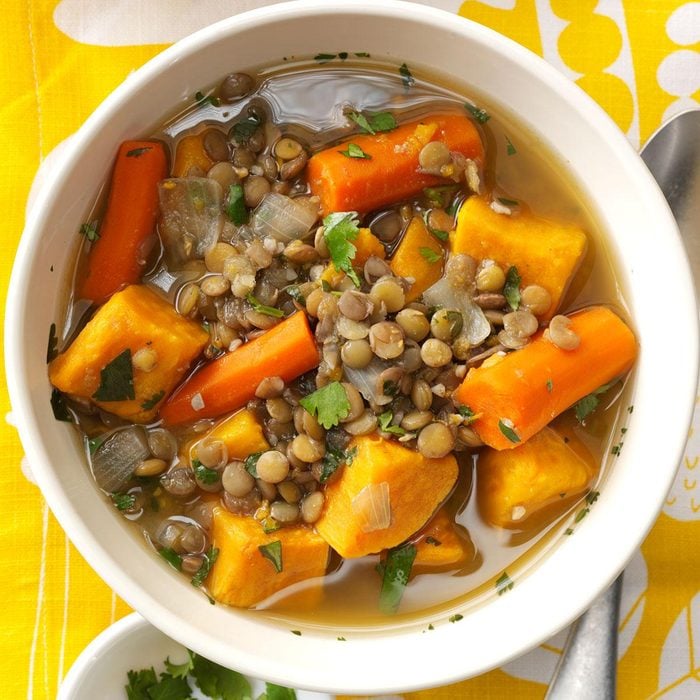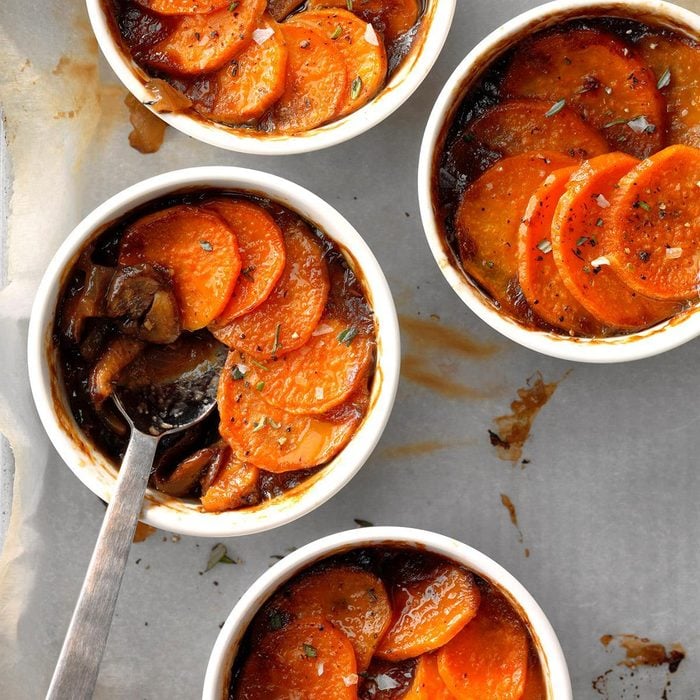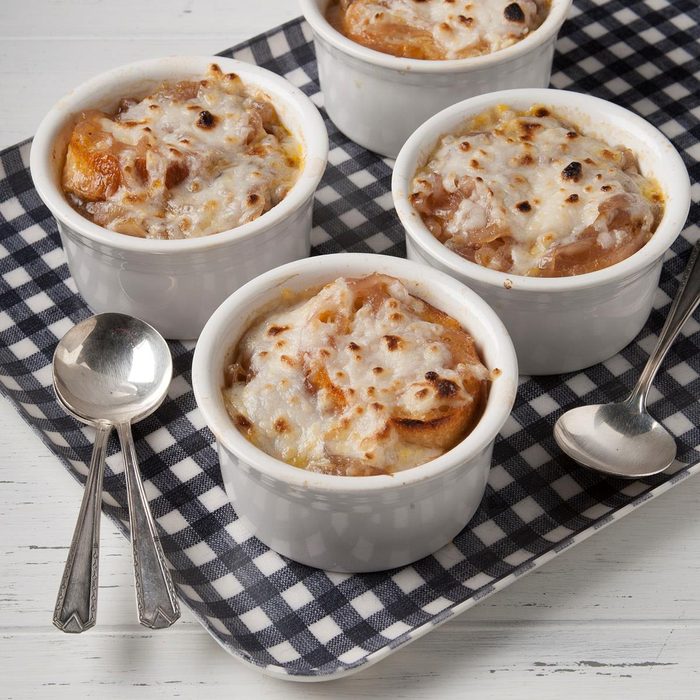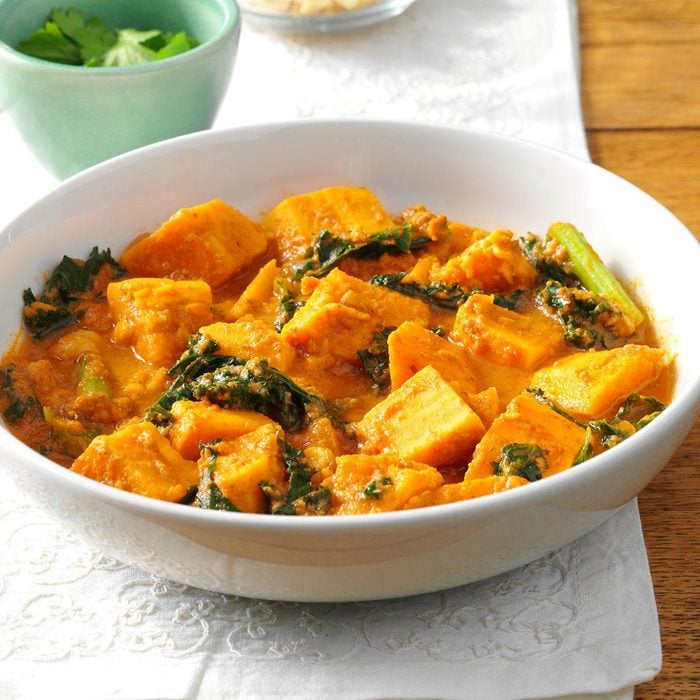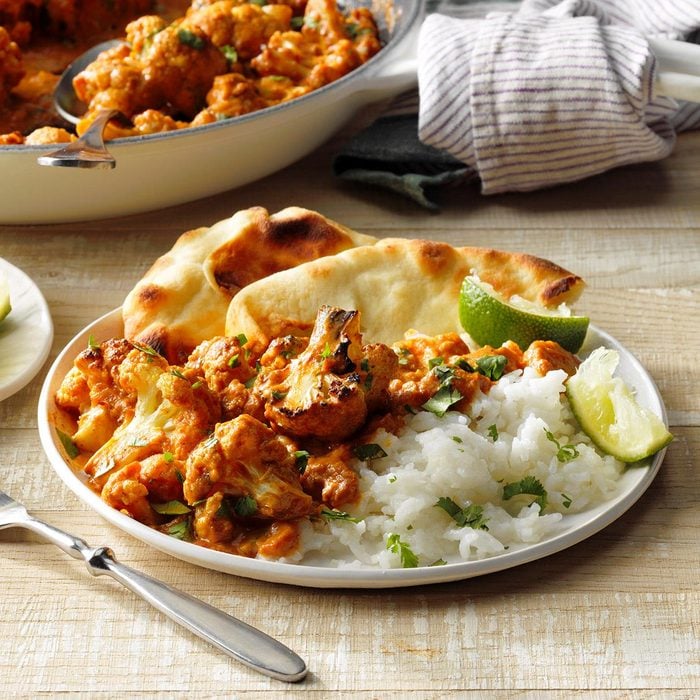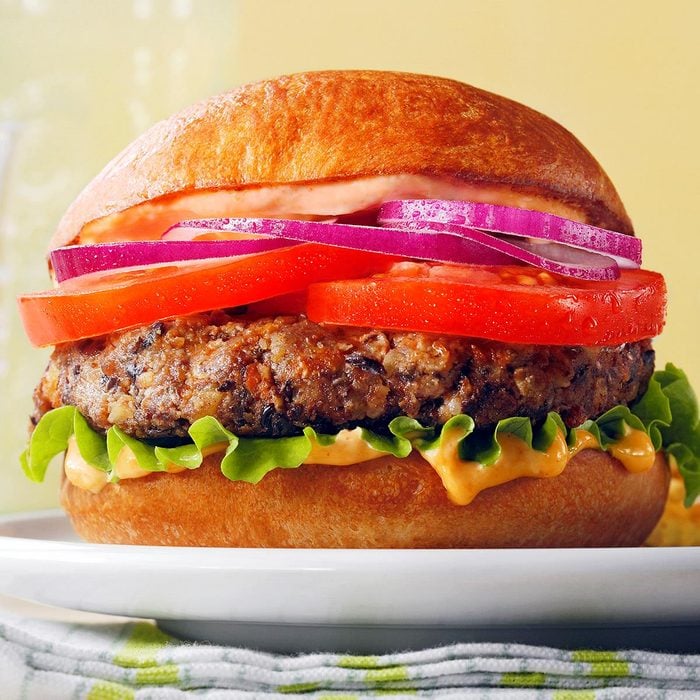Best Vegan Lasagna
Layers of tofu ricotta, spinach, mushrooms and vegan Italian sausage make up this hearty vegan lasagna recipe. Serve with a fresh loaf of bread and a lettuce salad.
Whether you’re a vegan or simply trying to eat more plant-based foods, we have these vegan main dishes for you!
Go to Recipe
Crispy Tofu with Black Pepper SauceThe secret to
making good tofu? Cook dry tofu over high heat, ensuring a crispy exterior. Since tofu has a mild flavor, it goes well with virtually any seasoning, like this yummy, piquant black pepper sauce.
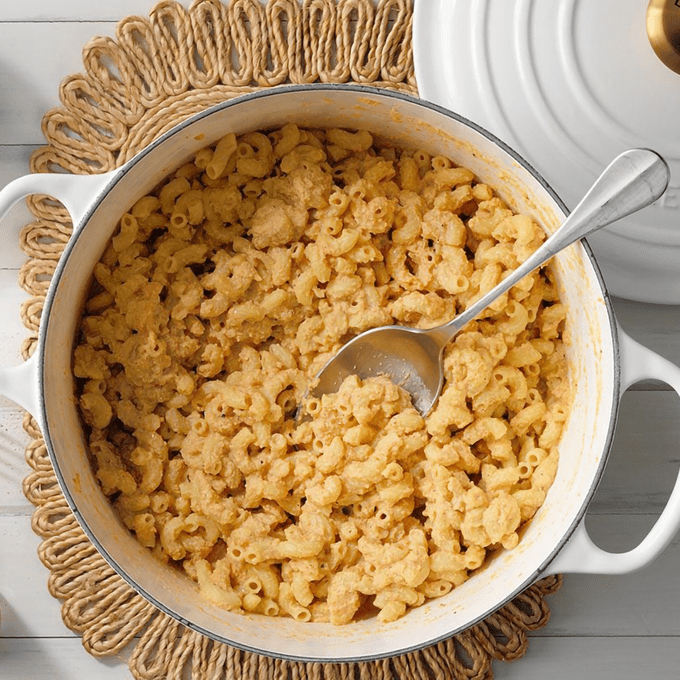 TMB Studio
TMB Studio
Sometimes, you just crave a familiar old friend. This vegan mac and cheese is every bit as savory and creamy as the classic version. The secret ingredient? Cashews, which make a creamy sauce—no dairy required.
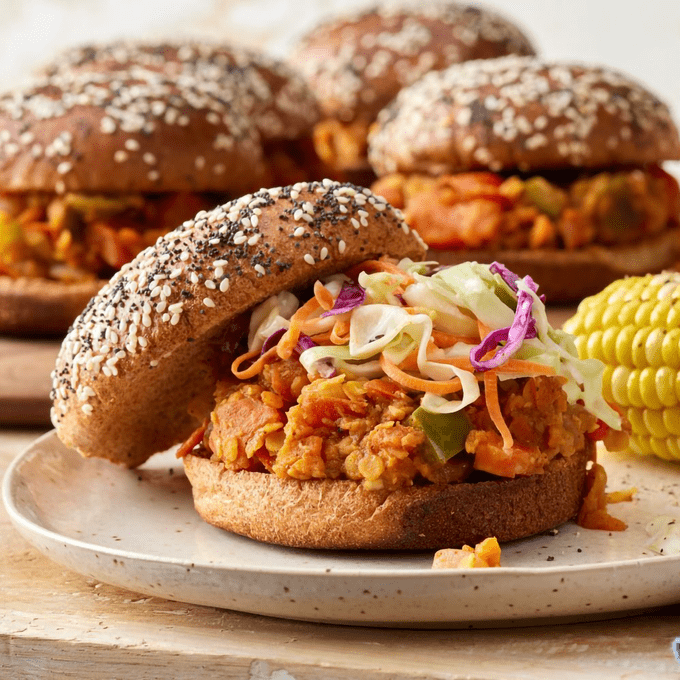 TMB Studio
TMB Studio
Pesto GnocchiPlump, tender gnocchi is always a treat! This recipe is simple, combining store-bought pesto and gnocchi with a few vegetables; feel free to add beans, nuts or whatever vegetables you have at home to make a heartier meal.
Vegan Cashew Cream of Broccoli SoupTo make creamy broccoli soup without the cream, vegans turn to a surprising substitute:
cashews. Cooked and blended, the buttery, soft nuts transform into a creamy, mild sauce sans dairy.
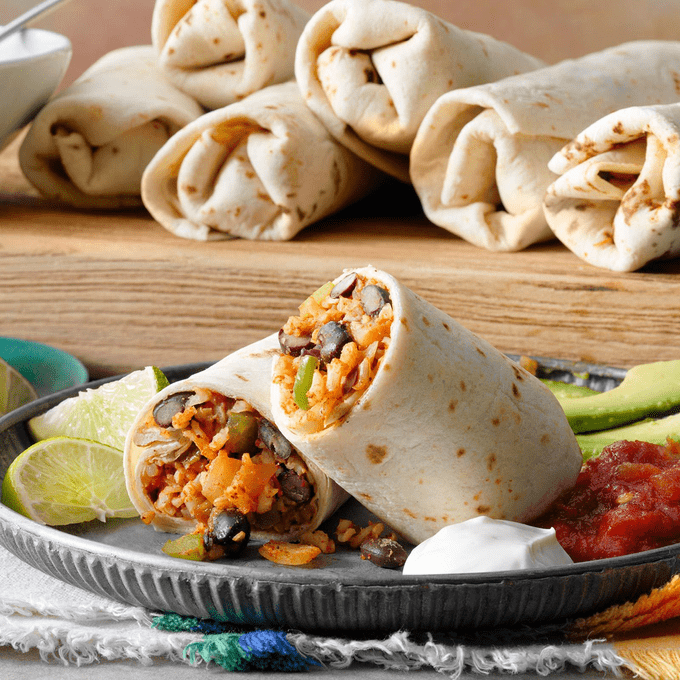 Tmb Studio
Tmb Studio
Having trouble finding a vegan burrito at the taco truck? Make one at home! Quick, healthy and flavorful, vegan burritos are also easy to adapt to your favorite fillings and spice tolerance. Serve with tortilla chips and
salsa.
Cool Beans SaladThis colorful bean salad wins rave reviews for its tasty Southwestern-inspired seasoning. Eating
beans and rice together makes a complete protein, full of the essential amino acids. This salad keeps well in the fridge, and tastes even better the second day.
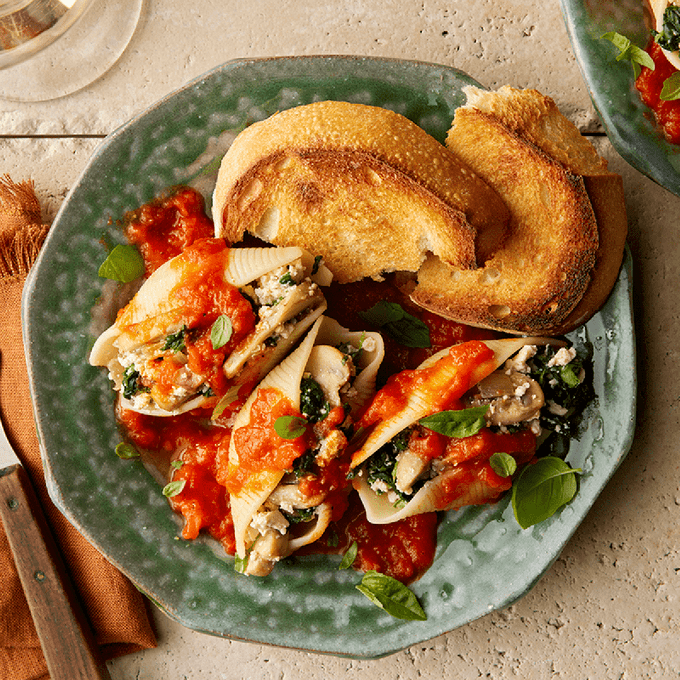 TMB Studio
TMB Studio
Traditional stuffed shells almost always include ricotta cheese for creaminess. This vegan recipe uses
silken tofu instead. It's so rich, you might not even notice the difference!
Salsa Bean BurgersCraving the savory comfort of a juicy burger? Put these bean burgers on your list! Adding salsa to the bean mix contributes both flavor and moisture. Important to note: You'll need to
replace the egg in the recipe with a vegan alternative, such as a flax egg or aquafaba (that's the liquid from a can of chickpeas, and it's surprisingly useful).
Soba Noodles with Ginger-Sesame DressingThis tasty vegan bowl offers up a delicious array of contrasts—soft soba noodles and crispy slaw; sweet ginger dressing and spicy chili sauce. Edamame are crunchy green soy beans, usually found pre-shelled in the frozen section. They add plenty of protein, but you can also add cubed tofu, raw or crispy.
Asparagus Tofu Stir-FryStir-fry might be the perfect vegan dinner: a quick one-pan meal that's endlessly adaptable and welcomes as many vegetables as you like. Tofu crisps up nicely in the high heat, and a simple sauce flavors every bite with spice, sweetness and tang. Here's
how to avoid soggy tofu.
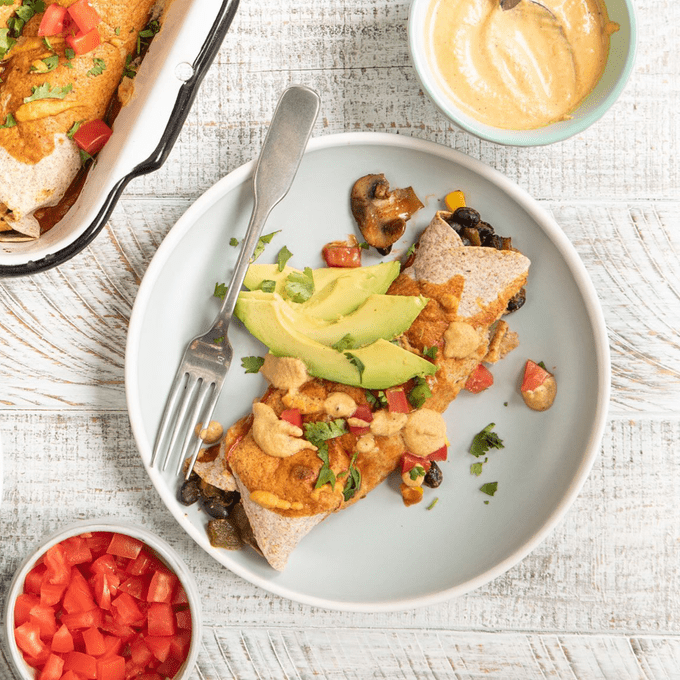 TMB Studio
TMB Studio
A cheesy sauce tops these spicy homemade enchiladas—but they're vegan. The secret? Creamy
faux cheese made from cashews and nutritional yeast.
Mushroom-Bean BourguignonAnother French classic, bourguignon is usually made with beef, but savory,
umami-rich mushrooms make a fabulous vegan substitute. Adding beans contributes both an earthy flavor and a hearty protein source.
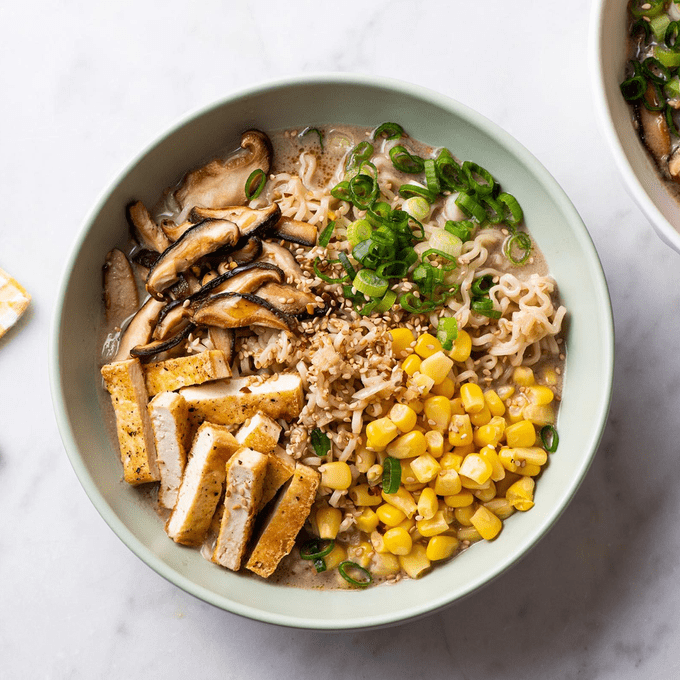 ALEXANDRA SHYTSMAN FOR TASTE OF HOME
ALEXANDRA SHYTSMAN FOR TASTE OF HOME
Hooked on ramen bowls? No need to eat ramen from the packet—it's a thousand times tastier homemade, and amazingly simple to prepare. This vegan recipe is full of fresh ingredients, with a savory sauce that's nothing like the sodium bomb you used to microwave in college.
Vegan Tortilla SoupCozy, spicy tortilla soup draws much of its character from the flavorful, tomato-based broth it cooks in. That makes it adapt well to a vegan twist; with the addition of quinoa for protein and texture, you won't even miss the chicken.
Black Bean & Corn QuinoaThis colorful vegan dinner is fun to make in summer, when fresh vegetables are in season, but it works just as well with frozen veggies. Cooking the quinoa in vegetable broth adds flavor (and masks any bitter taste you might find with quinoa; rinsing before cooking also helps). To make fluffy quinoa, be careful not to add too much broth to the pot.
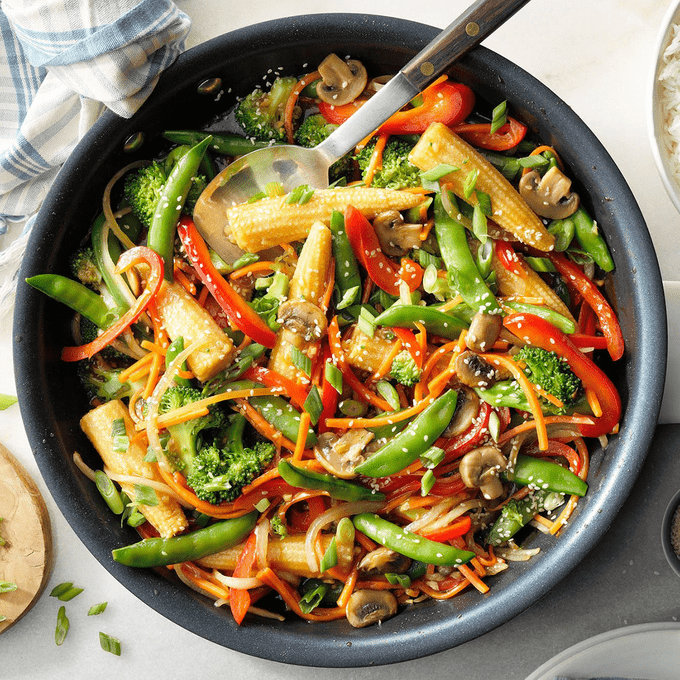 TMB Studio
TMB Studio
Learn to make this easy vegan stir-fry, and you'll be able to riff on it endlessly, every season of the year. The base recipe includes a cornucopia of vegetables (all of which you can adjust to your preferences). Feel free to add tofu,
tempeh or cashews for protein.
Black Bean & Sweet Potato Rice BowlsThis one-pan dinner features a triple dose of superfoods: sweet potato, kale and black beans. Make it a kid-friendly vegan recipe by leaving the chili sauce on the side.
Black-Eyed Peas ‘n’ PastaPasta is a delicious
vegan comfort food, no cheese required! This dish of pasta, peas and tomatoes is a
vegan recipe that will appeal even to meat eaters. If you don't have black-eyed peas, you can swap in chickpeas or white beans.
Chickpea & Potato CurryInspired by chana masala, a traditional Indian dish, this easy, not-too-spicy curry is a great entry point to cooking Indian food at home. Want to level up? Serve with homemade
naan.
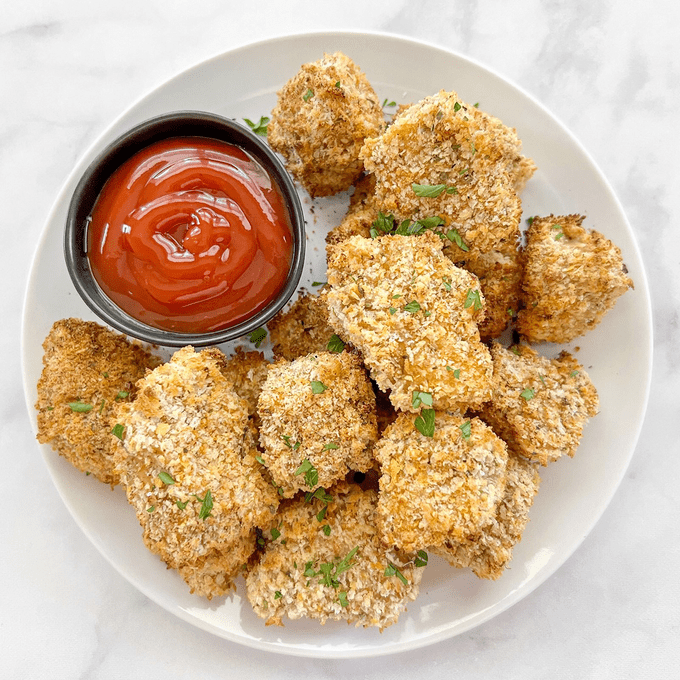 JENNA URBEN FOR TASTE OF HOME
JENNA URBEN FOR TASTE OF HOME
In this crispy dish, firm tofu masquerades as chicken. Mild in flavor and rich in protein, it's a great swap. As when
baking crispy tofu, the key trick is to drain it really well. If you don't have time to make it, then here are the
best vegan chicken nuggets from the grocery store.
Hearty Asian Lettuce SaladInspired by the flavors of your favorite Asian takeout, this salad is light and refreshing, yet packed with protein. It's a great winter salad, since it stars a navel orange, but in the summer you can make it with sliced nectarines.
Black Bean-Sweet Potato SkilletAromatic spices flavor this hearty skillet supper, featuring sweet potatoes, black beans and chipotle pepper. The black and orange bowls look festive in the fall, but this is an all-season dish. Add sliced avocado if you want extra protein (and because avocado is always a good idea).
Garden Quinoa SaladThis grain salad tastes great served hot or cold. Use whichever vegetables are in season, from spring asparagus to summer green beans to fall peppers. Add a vegan
meat alternative if you want a heartier meal.
Homemade Meatless Spaghetti SauceWith a jar of homemade tomato sauce in the fridge, you're always minutes from a great meal. Serve with your favorite
pasta shape, pour over roasted vegetables and polenta or use as a dip for crusty bread.
Market Basket SoupThis cozy vegetable soup is just the thing to make on those early fall days, when the days are warm but the nights are getting chilly. Kohlrabi looks like a root vegetable but is in the same family as cabbage and broccoli. If you can't find it, use a turnip or even plain old potatoes as a substitute. Serve with bread and a quality
vegan cheese.
No-Fry Black Bean ChimichangasThanks to the broiler, spicy, savory chimichangas get a super-crisp exterior—no deep-frying needed. This quick dinner is the perfect place to use up leftover rice hanging out in the fridge. Serve with sliced avocado or
guacamole.
Roasted Curried Chickpeas and CauliflowerRoasting chopped cauliflower, potatoes and chickpeas on a single sheet pan lets their flavors meld—and makes for easy clean-up. Add chopped, pressed tofu to the pan, if you'd like extra protein.
Vegan Spaghetti Squash with Balsamic VegetablesNot every vegan recipe is low-carb, but this one is. Spaghetti squash is a perfect substitute for noodles; its mild flavor matches most vegetables and spices, and its slightly sticky flesh clings to every drop of sauce. Add chopped nuts for a protein boost.
Jackfruit TacosA surprising meat alternative,
jackfruit is a versatile ingredient to keep in your vegan pantry. Its sweetness works well in this vegan taco inspired by pulled pork.
Mediterranean ChickpeasClassic Mediterranean flavors brim in this vegan bowl: think olives, artichokes and oregano. Couscous is a natural pairing, but if you're
gluten-free, you can use brown rice, quinoa, millet or whole grain sorghum.
Thai Pasta with Spicy Peanut SaucePeanut sauce makes everything taste delicious, especially yummy noodles. If you're a fan of
tofu recipes, cubes of the soft protein would make an excellent topper.
Slow-Cooker Vegan ChiliA good pot of chili overflows with smoky, savory and spicy flavors. This top-rated recipe is so packed with beans, corn and peppers, you won't even notice the lack of meat. Serve at a party after a starter of
vegan charcuterie.
Tuscan Portobello StewPortobello mushrooms are so hearty, they're a great vegan alternative to beef. If you crave a steak, try grilling portobellos and serving them whole. Or, try this savory Italian-inspired stew, which wins top ratings for flavor and ease.
Tropical Fusion Salad with Spicy Tortilla RibbonsThe best salads offer up an abundance of colors, textures and flavors. This sweet and spicy tropical salad is a prime example. Every bite is a bit different thanks to a mix of creamy avocado, tender papaya, crunchy corn and crispy tortilla strips.
Zippy Zucchini PastaPasta has a reputation as a comfort food, but it can also lean light and bright. In this vegan pasta, angel hair noodles are simply dressed with spicy tomatoes, diced zucchini and parsley flecks. Serve with a simple salad dressed in a
vinaigrette (so long as you make one without honey!).
Viva PanzanellaNever throw away stale bread—it's so useful! Turn it into breadcrumbs, croutons or this delicious bread salad. Tossed with ripe tomatoes, the bread softens and soaks in flavor. Add your favorite summer vegetables and white beans for a speedy dinner.
Vegetarian Black Bean PastaMake sure to put mushrooms on your
plant-based grocery list. In addition to being nutritious, they add a subtle savory note to dishes. Along with the black beans and whole wheat fettuccine, this is a wonderfully filling meal.
Barley Vegetable SoupBarley is higher in fiber than white rice, making it a hearty backbone for this soup. Its mild, earthy flavor tastes great with vegetables, and it adds a wonderful texture when mixed into the broth. Serve with bread and a good store-bought
vegan butter.
Penne with Veggies and Black BeansWhen your garden has a bumper crop of vegetables, make this pasta! Fresh herbs and tomato flavor the abundant vegetables and noodles. While you must omit the Parmesan cheese to make it vegan, you can substitute
nutritional yeast, which has a cheesy flavor.
Grilled Lebanese SaladIt's a cliche that vegans eat salad for dinner, but sometimes you really do just want a fresh, filling salad. This Lebanese-inspired salad has a clever trick for lending a rich, meaty flavor: grilling mushrooms along with chunks of oiled bread. The smoky, grilled flavor is just the right balance to the bright herbs and balsamic dressing.
Chard & White Bean PastaThis pasta dish is not only vegan but also gluten-, soy- and nut-free, making it ideal for serving to groups with multiple allergies. That said, it's a delicious meal in its own right, so nobody will feel like they're missing a thing.
Store-bought marinara sauce gets an upgrade with dried herbs, leeks, sweet potatoes and a dash of balsamic vinegar.
Zippy Bean StewCooking good ingredients low and slow draws out so much rich flavor, you don't need much added fat. This wholesome bean stew gets its "zip" from canned green chiles, which you can incorporate based on your preferences. Use mild for less heat and fire-roasted for a more medium-heat.
Sweet Potato Lentil StewThe
slow cooker is our secret weapon for making cozy meatless soups all winter long. Earthy lentils and sweet potatoes are a classic combination. Go ahead and add extra vegetables to the pot, like chopped kale, spinach or corn.
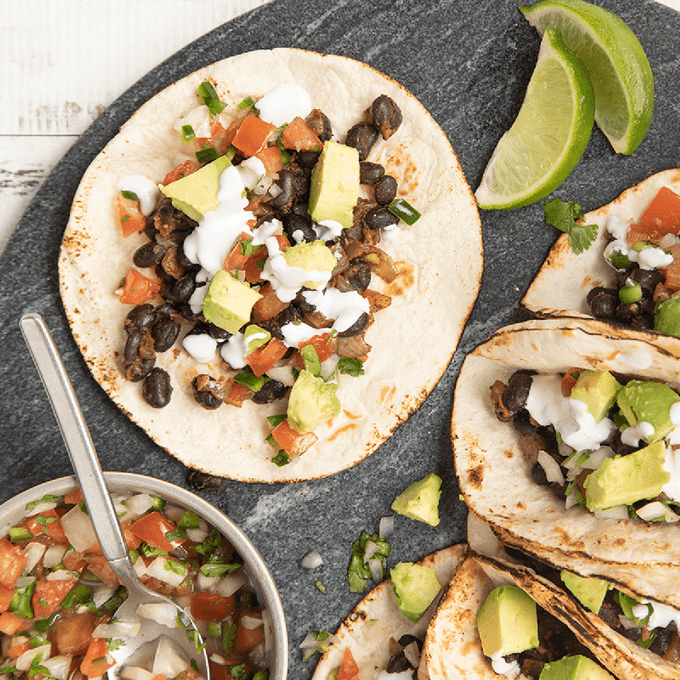 TMB Studio
TMB Studio
Tacos are an easy vegan dinner to put together on a busy weeknight! Many traditional taco fillings are already vegan, including black beans, guacamole and pico de gallo. Bonus points if you serve them on
homemade tortillas.
Mushroom and Sweet Potato PotpiePotpie might be the ultimate comfort food. This one, inspired by a classic British stout pie, is entirely vegan, relying on two kinds of mushrooms (plus mushroom broth), dark beer, onions and soy sauce for a rich umami flavor in every bite.
Vegan French Onion SoupTraditional French onion soup calls for beef broth and an oozing layer of cheese. In this vegan recipe, a mound of onions is slow-cooked until caramelized, sticky and melting, and then mushrooms, garlic, balsamic vinegar and soy sauce go into the pot to provide plenty of flavor. Use a good dairy-free mozzarella on top.
African Peanut Sweet Potato StewPeanuts and sweet potatoes are a classic flavor combination in many African cuisines. In this hearty soup, the sweet and savory flavors are perfectly balanced. Garbanzo beans and kale fill out the pot to make it a complete meal.
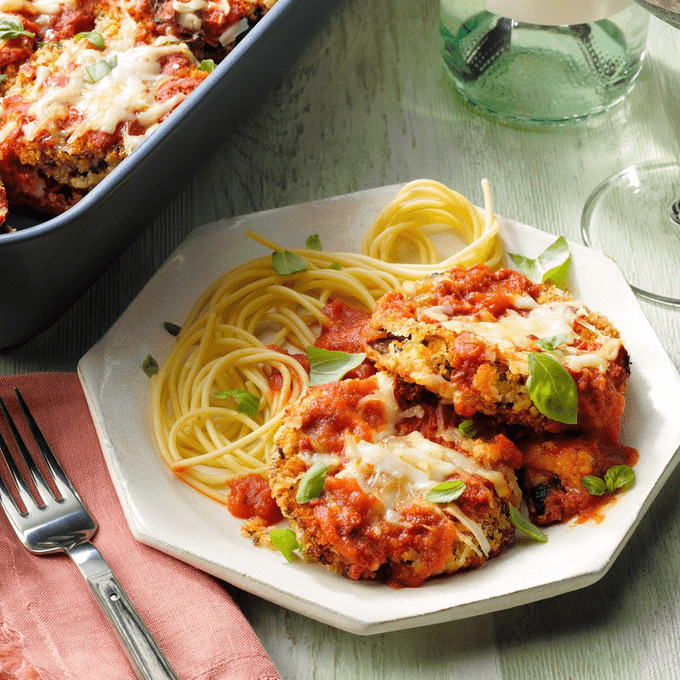 TMB Studio
TMB Studio
It's easy to translate eggplant Parmesan to a vegan diet, considering that the main ingredient is already vegan! Look for a plant-based cheese that will melt (the package will usually specify). Work this dish into your
vegan meal plan on a day you have extra time for prep, as the layering does take a while.
Vegan Butter CauliflowerInspired by Indian butter chicken, this delicious dish swaps in cauliflower. Like chicken, the mild vegetable takes on the flavorings of any dish, so it's a great one to keep in the crisper.
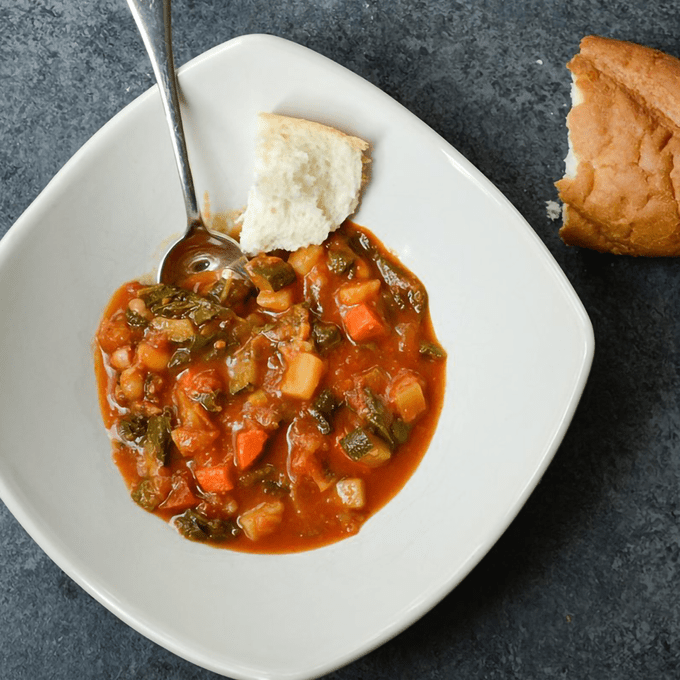 JENNIFER SCHWARZKOPF FOR TASTE OF HOME
JENNIFER SCHWARZKOPF FOR TASTE OF HOME
Few soups are as healthy or comforting as minestrone. This vegetable-packed recipe is made especially rich with a surprising ingredient: aquafaba, which is the liquid from the can of beans.
Best Ever Veggie BurgerTo make a good veggie burger, you need a faux meat mix with plenty of flavor and enough moisture to stand up to cooking without falling apart. In this recipe, black beans and oats add heft, while walnuts and sun-dried tomatoes provide both flavor and oil.
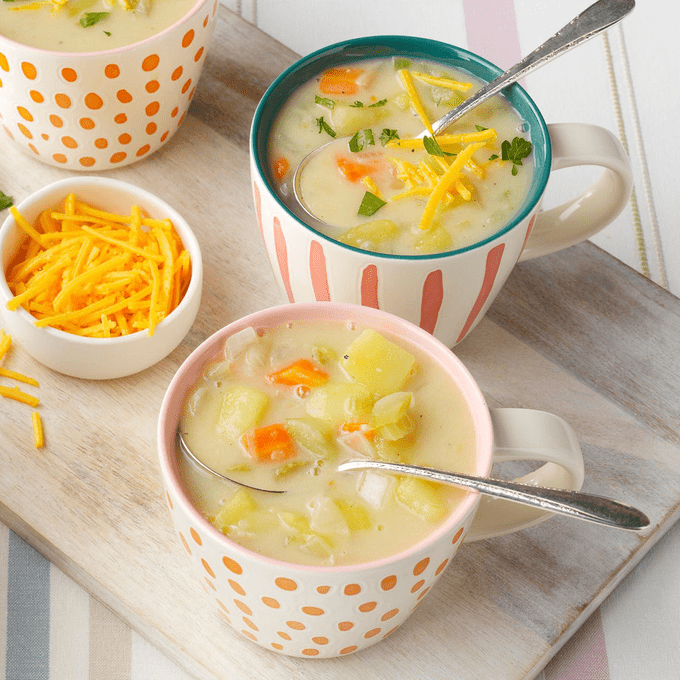 Tmb Studio
Tmb Studio
What's cozier than potato soup? This easy recipe doesn't need any dairy—it doesn't even require a blender! To maintain creaminess, this recipe uses soy milk and vegan butter-style sticks.
Lemon Mushroom OrzoA filling, zesty bowl of orzo is the perfect cozy dish after a tiring day. A little
lemon zest goes a long way for flavoring this dish, and the mushrooms and pecans give the dish more buttery, foresty notes.
Arrayskyword_tracking_tag[/c























